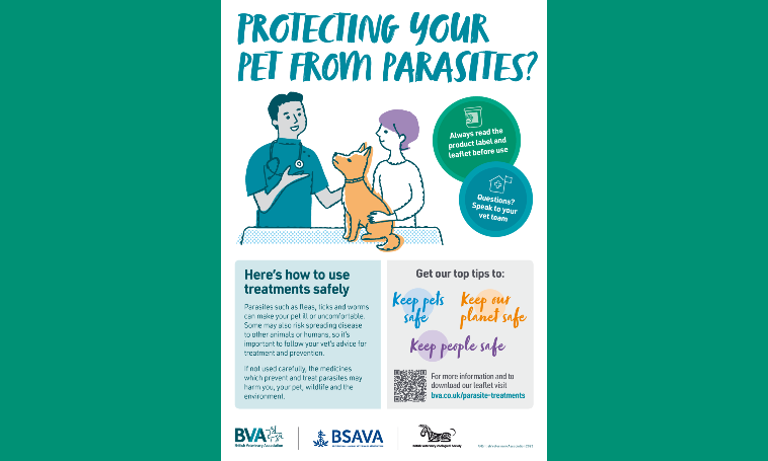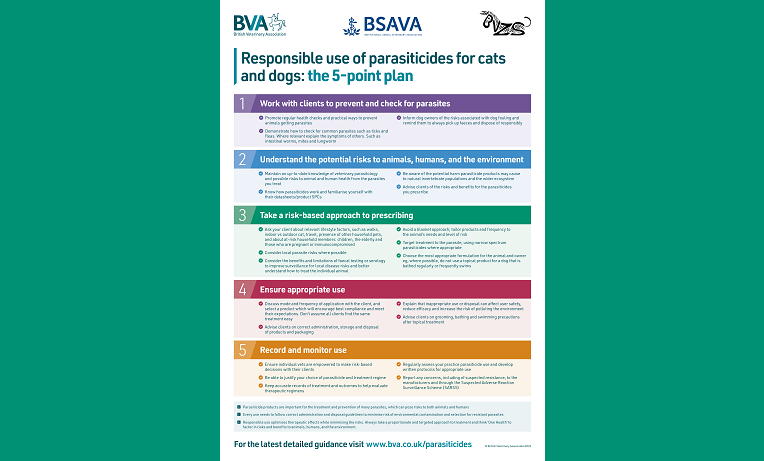Responsible use of parasiticides for cats and dogs
What’s the issue?
Parasiticide products are commonly used on cats and dogs to prevent and treat for various parasites, including fleas, ticks and worms. As well as preventing many animal health and welfare problems, these treatments help to prevent human health risks from associated zoonotic threats, and these concerns have led to widespread routine use of parasiticide treatments in the UK.
However, there is increasing evidence from multiple sources that some parasiticides are contaminating the environment, including through wastewater from homes, animals entering waterways outdoors, excretion in faeces and urine, and residues in pet fur. As parasiticides can be harmful to a range of non-target species, this can be detrimental to wildlife and ecosystems, which could in turn impact on public health.
Given the importance of being able to use these products, we need to ensure they are used responsibly so they continue to remain available and effective in the future, whilst being used in a way that minimises harm to the environment
This is a complex and evolving One-Health issue, and our position is kept under review as the evidence base grows. This policy was originally published in 2021, and updated in 2025 to reflect the latest research.

What’s our view?
BVA, BSAVA and BVZS are calling for a more considered, risk-based approach to the use of small animal parasiticides. Everyone must take concerns about the possible environmental impacts seriously, proactively promoting discussion and highlighting these challenges.
A range of stakeholders need to take action to support responsible parasiticide use. Our priorities for action are listed below:
Priorities for action
There are many knowledge gaps in relation to parasites and the use of parasiticide products which make risk analysis difficult. Our policy position highlights those gaps, which most urgently include:
- factors that can impact the risk of pets being infected by parasites, including seasonality, multi-pet households, geography, lifestyle factors and pet factors, and optimal use of parasiticides to control those risks, including frequency of administration.
- risks to animal and human health from common parasites, and prevalence in human and animal populations.
- prevalence and impacts of veterinary parasiticide products in the natural environment, including impacts on non-target species. This should include all commonly used parasiticides, in addition to fipronil and imidacloprid, and consider the impacts of long acting and combination products.
Everyone prescribing parasiticides has a role to play in ensuring they are used responsibly, and should:
- ensure they understand the risks associated with parasiticide treatments and are able to advise clients appropriately, and always take a proportionate and targeted approach to prevention and treatment.
- avoiding blanket treatment, instead risk assessing use of parasiticides for individual animals, and where possible and reasonable, avoid prescribing topical products for pets which are likely to swim or be bathed. Businesses should empower individual vets to discuss tailored treatment plans with their clients, and allow for risk assessment within practice health plans so vets can base prescribing decisions accordingly.
As the regulator for veterinary medicines, the VMD should:
- review the requirements for environmental impact assessment of companion animal parasiticide products.
- reconsider the classification of parasiticides which are currently AVM-GSL.
Manufacturers of parasiticide products should:
- further improve information provided with veterinary medicines to ensure that key points on safe usage are clearly and simply presented, with support from regulatory bodies.
- prioritise development of a narrow spectrum product for lungworm, as opposed to combination products, to reduce the need for overtreatment.
All stakeholders should collaborate to:
- address the potential for resistance, taking lessons from previous work on antimicrobial resistance (AMR), including by encouraging reporting of suspected resistance to the VMD to support monitoring and further research.
- educate pet owners on the correct use of parasiticide products, how to prevent animals getting parasites, and how to check for them.
View our policy documents
Resources
Client resource pack
Please note: these resources were developed in line with the original 2021 policy position and are currently being reviewed in light of the 2025 update
We've developed a resource pack to help you speak to your clients about how to responsibly use parasiticides for dogs and cats, ensuring any negative impacts to pets, people and the planet are minimised.
Download our:
- Posters
- Leaflet
- Practice screen slides
To download our practice screen slides in mp4 format, please contact [email protected].

Five point plan poster
We're urging veterinary professionals to always take a risk-based approach to prescribing parasiticides. It's important to consider the risks to animal, human, and environmental health.
Our five-point plan poster has been developed in collaboration with BSAVA and BVZS to support veterinary professionals in decision making around the use of parasiticides.

Get involved
Contact our policy team for more information
